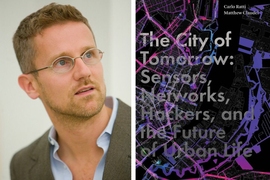Amsterdam is one of the most bike-friendly major cities in the world. That also means the city is a happy hunting ground for thieves, who steal tens of thousands of bikes per year — a substantial chunk of the estimated 850,000 or so that Amsterdam residents own. Which raises some questions. Where do all the stolen bikes go? Are they shipped elsewhere and sold? Tossed in canals? Or just reused in the city by other people?
Now an MIT experiment, in collaboration with the Amsterdam Institute for Advanced Metropolitan Solutions and Delft University of Technology, has found answers by equipping a fleet of Amsterdam bicycles with mobile trackers and following their whereabouts over time. It turns out that, at least in Amsterdam, the vast majority of stolen bikes remain in the local area. A substantial amount appear to get resold, meaning most simply keep circulating in the city’s bike fleet, one way or another.
“I think the most surprising thing was that it’s happening locally,” says Fabio Duarte, principal research scientist at MIT’s Senseable City Lab and co-author of a new paper detailing the experiment’s results. “We thought bikes might be stolen and sent abroad. We found they are used in the same [locations]. If they’re stolen and sold, the new owner uses the bike in the same areas, probably without knowing it was stolen. There are so many bikes in Amsterdam, you’re likely never going to know it was yours.”
The paper, “Tracking Stolen Bikes in Amsterdam,” is published today in PLOS ONE. The authors are Titus Venverloo, a research fellow at the MIT Senseable Amsterdam Lab in the Amsterdam Institute for Advanced Metropolitan Solutions; Duarte, who is also a lecturer in MIT’s Department of Urban Studies and Planning (DUSP); Tom Benson, a research fellow at the Senseable City Lab; Pietro Leoni, a research fellow at the Senseable City Lab; Serge Hoogendoorn, a distinguished professor of smart urban mobility at Delft University of Technology; and Carlo Ratti, director of the Senseable City Lab.
“At the lab we have been using smart tags for several purposes — for instance to better understand illegal electronics waste routes across the world,” says Ratti. “In this project we turned our focus to a key issues in Amsterdam and many other cities: stolen bikes.”
In recent years, around 11,000 bicycles have been reported stolen in Amsterdam per year; the city estimates that the total number actually stolen is higher, around 28,500 per year. Cycling advocates suggest the number may be even higher, around 80,000 per year. Whatever the proper estimate, bike theft is a hazard that accompanies bike-friendly urban design.
“Almost everybody in Amsterdam, or even in Cambridge, if you ride a bike, has had the experience of leaving somewhere and not finding their bike,” Venverloo says.
To conduct the study, with the approval of municipal officials, the researchers placed low-cost tracking devices on 100 second-hand bicycles in Amsterdam, locked them in public locations, and tracked them from the beginning of June 2021 until the end of November 2021. During that time period, 70 of the bikes were stolen — a rate that is higher than the estimated Amsterdam average, probably because they were entirely kept in public places.
The research team also charted the movement of the bikes. Out of the 70 stolen bikes, 68 remained in the local Amsterdam area. Between three and six of those spent enough time in the vicinity of second-hand bike stores that the researchers concluded they were probably sold there. Another 12 bikes were taken to locations identified as places where bicycles are known to be sold informally, on the bicycle black market.
The scholars found that still another 22 of the bikes made such sufficiently similar movements that they seemed to be part of the same “subnetwork” of bikes.
“What we found is that we can indeed investigate this and say something about the level of organization, by doing network analysis and really looking into the data,” Venverloo says.
While the experiment did not yield answers about every bicycle, and was not used to pursue criminal cases, the research team notes it did yield valuable information about the nature of Amsterdam’s bike-theft problem.
“Having this inexpensive technology, at least you start seeing patterns,” Duarte says. “Now you know where to be focused.”
The research outcomes have been shared with Amsterdam officials working on bike theft in the city, who can use the insights to help the municipality further address the problem.
"Every year, the bikes of tens of thousands of Amsterdam residents are stolen,” says Melanie van der Horst, the alderman for traffic and transport, and the deputy mayor of Amsterdam “They must buy a new bike, while their bike is sold again somewhere else in the city. This research makes it clear that part of bicycle theft is organized."
For his part, Venverloo says, “It’s great news that they’re interested and they’ve seen the results. They can resolve if they need to work locally or collaborate with other cities. It’s given them insight about geographic boundaries.”
The research was not connected to programs Dutch police already use to catch bike thieves; indeed, to preserve privacy, once researchers saw clear patterns in a bicycle’s movement, suggesting the bike was in regular use by someone who might not have known it was pilfered, the team stopped collecting data.
The researchers note that the experiment provides potential applications beyond the scope of bicycle theft — including the waste-tracking projects Senseable City Lab has undertaken — that could similarly track other types of goods vulnerable to theft. The study also provides data about mobility patterns that could be applied to urban design.
The research was supported, in part, by the Municipality of Amsterdam; the Delft University of Technology’s Transport Institute; Senseable City Lab; and the Amsterdam Institute for Advanced Metropolitan Solutions.











